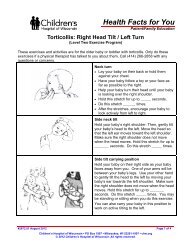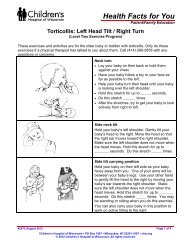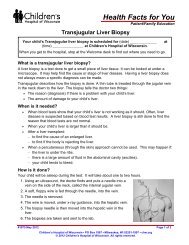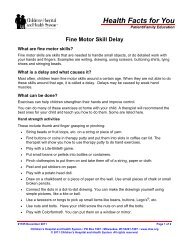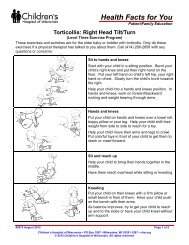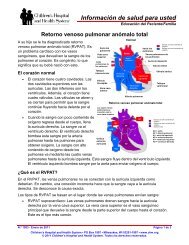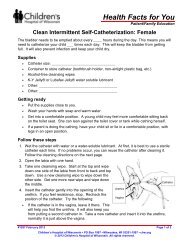Health Facts for You - Children's Hospital of Wisconsin
Health Facts for You - Children's Hospital of Wisconsin
Health Facts for You - Children's Hospital of Wisconsin
You also want an ePaper? Increase the reach of your titles
YUMPU automatically turns print PDFs into web optimized ePapers that Google loves.
<strong>Health</strong> <strong>Facts</strong> <strong>for</strong> <strong>You</strong><br />
Patient/Family Education<br />
Total Anomalous Pulmonary Venous Return<br />
<strong>You</strong>r child has been diagnosed with total<br />
anomalous pulmonary venous return<br />
(TAPVR). It is a heart problem with the blood<br />
vessels that return blood from the lungs to the<br />
heart. It is congenital, which means your baby<br />
was born with it.<br />
The normal heart<br />
• The heart has four chambers. The upper<br />
two chambers are the atria. The lower<br />
two are the ventricles. The heart also<br />
has four valves. The valves open and<br />
close to keep blood flowing <strong>for</strong>ward<br />
through the heart.<br />
• When blood that is low in oxygen comes<br />
back from the body, it fills the right<br />
atrium. The blood goes to the right<br />
ventricle. The right ventricle pumps this<br />
blood through the pulmonary artery to<br />
the lungs to get oxygen. Oxygen-rich<br />
blood from the lungs goes through the<br />
four pulmonary veins to the left atrium.<br />
This blood flows into the left ventricle.<br />
The left ventricle pumps blood through<br />
the aorta to send oxygen out to the body.<br />
What is TAPVR<br />
With TAPVR, the pulmonary veins do not connect to the left atrium as they should. Instead,<br />
an incorrect connection makes blood go to the right atrium. The exact cause is not known.<br />
The types <strong>of</strong> TAPVR are based on where the pulmonary veins send blood:<br />
• Supracardiac TAPVR: The pulmonary veins drain blood to the right atrium through the<br />
superior vena cava. The superior vena cava is the main blood vessel that returns blood<br />
from the upper part <strong>of</strong> the body to the heart. This is the most common type.<br />
• Cardiac TAPVR: The pulmonary veins drain blood to the right atrium directly or through<br />
the coronary sinus. The coronary sinus is the blood vessel that returns blood from the<br />
heart muscle itself.<br />
#1583<br />
January 2011 Page 1 <strong>of</strong> 3<br />
Children’s <strong>Hospital</strong> and <strong>Health</strong> System • PO Box 1997 • Milwaukee, WI 53201-1997 • www.chw.org<br />
© 2011 Children’s <strong>Hospital</strong> and <strong>Health</strong> System. All rights reserved.
What is TAPVR (continued)<br />
Total Anomalous Pulmonary Venous Return<br />
• Infracardiac TAPVR: The pulmonary veins drain blood to the right atrium through the<br />
inferior vena cava or the hepatic (liver) veins. The inferior vena cava is the main blood<br />
vessel that returns blood from the lower part <strong>of</strong> the body to the heart. This type is more<br />
common in males.<br />
• Mixed TAPVR: This is a blend <strong>of</strong> the other types <strong>of</strong> TAPVR.<br />
With all types <strong>of</strong> TAPVR, the baby must have an atrial septal defect (ASD). An ASD is a hole<br />
in the septum, which is the wall between the heart’s two atria. It lets oxygen-rich and oxygenpoor<br />
blood mix. Because the blood that goes out to the body has less oxygen than normal, it<br />
makes your child’s skin, lips, and nails look blue. This is called cyanosis.<br />
What are the symptoms <strong>of</strong> TAPVR<br />
The symptoms <strong>of</strong> TAPVR depend on whether there is an obstruction (narrowing or blockage)<br />
in the pulmonary veins. Children with obstructed TAPVR are usually very sick as newborns.<br />
They have:<br />
• Trouble breathing.<br />
• Too much fluid in the lungs.<br />
• High blood pressure in the lungs.<br />
• Severe cyanosis.<br />
• Trouble feeding.<br />
Children with unobstructed TAPVR may have no symptoms or:<br />
• Mild cyanosis.<br />
• Trouble breathing. This may be mistaken <strong>for</strong> pneumonia or a cold.<br />
How is TAPVR diagnosed<br />
• It may be detected with a fetal ultrasound be<strong>for</strong>e a baby is born. This test uses sound<br />
waves to <strong>for</strong>m a picture <strong>of</strong> the baby’s heart. This test can be done after the mother is 16<br />
weeks pregnant.<br />
• If it is not detected be<strong>for</strong>e birth, signs <strong>of</strong> a heart problem may be found during a<br />
physical exam shortly after birth.<br />
• If a heart problem is suspected, your baby will be referred to a doctor who diagnoses<br />
and treats heart problems in children. This doctor is called a pediatric cardiologist.<br />
Several tests may be done. These include:<br />
– Chest X-ray: Shows inside the chest, including the lungs and the heart.<br />
– Electrocardiogram (EKG): Records the heart’s electrical activity.<br />
– Echocardiogram (echo): Looks at a moving picture <strong>of</strong> the heart.<br />
– Pulse oximeter or oxygen saturation test: Measures the oxygen level in the<br />
blood.<br />
– Cardiac catheterization: Looks at the structure <strong>of</strong> the heart and measures the<br />
blood pressure and oxygen level in different parts <strong>of</strong> the heart.<br />
#1583 January 2011 Page 2 <strong>of</strong> 3
How is TAPVR treated<br />
Total Anomalous Pulmonary Venous Return<br />
All types <strong>of</strong> TAPVR are repaired with heart surgery. During surgery, the pulmonary veins are<br />
connected correctly to the left atrium. The ASD is also closed. The timing <strong>of</strong> the surgery<br />
depends on how sick your child is.<br />
After surgery your baby will go to the cardiac intensive care unit to be monitored. <strong>You</strong>r baby<br />
may stay in the hospital <strong>for</strong> 2 to 3 weeks.<br />
What are the long term concerns<br />
• After repair <strong>of</strong> TAPVR, most children can be active. The type and amount <strong>of</strong> physical<br />
activity vary with each child. Check with the cardiologist about which activities are right<br />
<strong>for</strong> your child.<br />
• Regular follow-up visits with the cardiologist are needed <strong>for</strong> the rest <strong>of</strong> your child’s life.<br />
• Rarely, a repaired pulmonary vein may become blocked.<br />
• <strong>You</strong>r child may need to take antibiotics be<strong>for</strong>e having any surgery or dental work. This<br />
is to prevent infection <strong>of</strong> the inside lining <strong>of</strong> the heart and valves. This infection is called<br />
infective endocarditis. <strong>You</strong>r child should take antibiotics as directed by the cardiologist.<br />
ALERT: Call your child’s doctor, nurse, or clinic if you have any questions or<br />
concerns or if your child has special health care needs that were not covered in<br />
this sheet.<br />
This teaching sheet is meant to help you care <strong>for</strong> your child. It does not take the place <strong>of</strong> medical care.<br />
Talk with your healthcare provider <strong>for</strong> diagnosis, treatment, and follow-up.<br />
#1583 January 2011 Page 3 <strong>of</strong> 3




